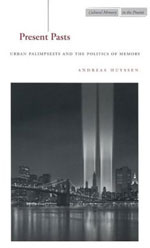 by Andreas Huyssen, essays written 1996-2002
by Andreas Huyssen, essays written 1996-2002
“Architecture has always been deeply invested in the shaping of political and national identities…” p. 49
I like the idea of palimpsests (and city as palimpsest), and I love studies of memory. The book didn’t quite live up to my preconceived high hopes (based solely on the title); nevertheless, the essays contain some good insight into modern attitudes toward architecture, history, and collective memory.
There are several good essays on Berlin—how the city had to fill the void after the Wall, and how the city continuously has had to respond to its past sins. The author refers to Berlin as a “city without a center,” which has also been used as critique and commentary on Los Angeles. It would be interesting the compare the two: Berlin without center due to politics and the torn-down Wall; L.A. without center due to city planners and a sometimes-useless (though constantly rethought and replanned) downtown.
As far a physical manifestations and rewritings of memory: there is a bit about Christo‘s wrapping of the Reichstag, Daniel Libeskind‘s Jewish Museum, Doris Salcedo, war memorials, and more. Huyssen addresses the modern/postmodern concerns of commodification and kitsch.
“Perhaps the wrapping of the Reichstag, which can now be seen only in reproducible media images on postcards, T-shirts, coffee cups, and the Internet, is symptomatic of the fate of the monumental in our postmodern times: it has migrated from the real into the image, from the material into the immaterial, and ultimately into the digitized computer bank.” p. 47
“Drawing on the standard Adornean argument that commodification equals forgetting, they argue that the marketing of memory generates nothing but amnesia.” p. 21
One of my favorite parts is the idea of a “ruin theory of architecture.” There is beauty and sadness in ruins, which are therefore pretty easy to romanticize (just as people romanticize the past based on remnants of history and memory). Ruins are history, as in the past. Ruins are history, as in they are no longer. And ruins are history, as in they remind us of what we are not now. [See Cabinet magazine’s issue on ruins.]
“The leitmotiv of architecture in ruins provides mythic closure to Wagner’s romantic quest: what is being built is always already a tomb, a memorial to failure and disaster. Wagner’s antipathy toward the monumental as classicist norm is grounded in his imaging the monumental as ruin only, for only ruins have permanence. This is where a nineteenth-century discourse of the monument as ruin meets with Albert Speer’s ruin theory of architecture, which had the express intent to build in such a way that the greatness of the Third Reich would still be visible in its ruins a thousand years hence.” p 45 (cf Shelley’s “Ozymandias” and Derrida for “always already”)
Another interesting thread through the essays has to do with how memory will live into the future and explores the practicality, realism, and possibilities of technological memory (archives, internet, computers).
“At the same time, cyberspace alone is not the appropriate model for imagining the global future. Its notion of memory is misleading, a false promise. Lived memory is active, alive, embodied in the social…” p. 28
“Especially since 1989, the issues of memory and forgetting have emerged as dominant concerns in postcommunist countries in Eastern Europe and the former Soviet Union…” p. 14 (see Kundera’s The Book of Laughter and Forgetting et al)

….”It would be interesting the compare the two: Berlin without center due to politics and the torn-down Wall; L.A. without center due to city planners and a sometimes-useless (though constantly rethought and replanned) downtown.”
See:
Temporary Art and Public Place: Comparing Berlin with Los Angeles (Europaische Hochschulschriften. Reihe 28: Kunstgeschichte /) [Paperback] by John Powers.
By the way, John Powers (johnpowers-art.com) is also the artist who placed a replica of the Statue of Liberty on the last guard tower at Checkpoint Charlie. See page 53 of Huyssen’s essays. Unfortunately, Andreas Huyssen does not seem to care about copyrights of images at all, nor did he think it would be necessary to at least ask the artist before using the image.